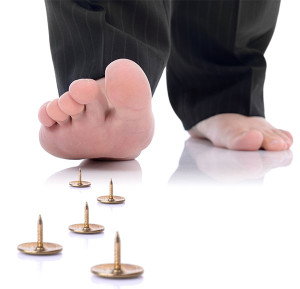 PERIPHERAL NEUROPATHY is a condition where the feeling in your feet or hands is abnormal. There may be tingling, or pain or numbness. These problems often develop slowly, are irritating and often worsen over time. The condition frequently interrupts sleep in the early hours of the morning. Without a specific diagnosis as to the cause of peripheral neuropathy, and there are many causes, it may not be wise to use drugs or other treatments for a neuropathy problem.
PERIPHERAL NEUROPATHY is a condition where the feeling in your feet or hands is abnormal. There may be tingling, or pain or numbness. These problems often develop slowly, are irritating and often worsen over time. The condition frequently interrupts sleep in the early hours of the morning. Without a specific diagnosis as to the cause of peripheral neuropathy, and there are many causes, it may not be wise to use drugs or other treatments for a neuropathy problem.
Is there a cure?
No device, drug or magic compound can legally claim to cure but several treatments appear to be able, IN SOME PATIENTS, to alleviate the symptoms.
What are typical causes?
Diabetes is high on the list as a major contributor to the cause of peripheral neuropathy. Another is peripheral neuropathy resulting from chemotherapeutic drugs. Some genetic diseases, such as Charcot Marie Tooth that involve nerve damage, also cause symptoms of peripheral neuropathy. Pain in the lower extremities is a major symptom of vascular disease known as peripheral vascular or peripheral arterial disease (PVD and PAD, respectively).
What are contributing & controllable factors?
Vascular disease is the leading contributing yet controllable factor. For example, in diabetic patients vascular problems occur throughout the body. These patients suffer from vascular injury to the eyes, heart, kidney and not surprisingly, to the lower legs and feet themselves. In fact, if left unaddressed, poor blood flow to the feet can often lead to the formation of ulcers. In many cases, these wounds are so difficult to heal that an amputation is required.
What are typical complications?
Slow or non-healing wounds & ulcers have been mentioned. Poor blood flow to nerves causes loss of sensation and subsequent difficulty in walking and balance. Imagine not being able to pick up a fork or a sewing needle because you’ve lost feeling in your fingers. Imagine not being able to sense an uneven surface while walking or a hot surface while bathing. Imagine not being able to know whether your foot is on the break or accelerator.
What are typical treatments?
Typical treatments include drugs that do not affect the vascular problems but tend to inhibit the painful symptoms. Other oral approaches involve nutritional supplements that increase blood flow. If the symptoms of neuropathy in the legs and feet become very severe sometimes surgery on the blood vessels in the legs is suggested.
Are all peripheral neuropathies the same?
No, as mentioned above, some are due to disease, some to toxins like chemotherapy drugs, some are due to genetics, some are due to infections such as Lyme disease, and some are simply unexplained. The latter are labeled idiopathic neuropathy, which means the cause is unknown.
What is polychromatic light therapy?
Light emitting diodes (LEDs) are a part of medical devices that emit near infrared (IR) light or light of various colors (polychromatic). Unlike blue, red or yellow light, IR light is invisible to the human eye. The IR light has been reported in the scientific literature to dilate blood vessels at the site of treatment.
What is the bio/physiological reaction to infrared light?
Scientific evidence shows that IR light triggers the release of nitric oxide from blood vessels and from red blood cells at the site of treatment. Nitric oxide causes local vasodilation that lasts several hours after the treatments cease. Vasodilation improves blood flow and is useful in patients whose peripheral neuropathy is due to poor blood flow.
How does this apply to peripheral neuropathy?
Improving blood flow lessens what is known as “ischemic” pain and helps nerves to begin to carry sensations again. Remember, sensory loss due to poor blood flow to nerves is a symptom of peripheral neuropathy.
Why are there differences in responses?
Some patients have idiopathic neuropathy which may not respond to light therapy whereas others with vascular damage (poor blood flow) often experience relief from the symptoms of neuropathy.
How often is it used?
Light therapy, by a licensed healthcare provider, is typically given for a minimum of three times a week for 8-12 weeks. This time frame is due to the overall patient load at a clinic or the logistics of getting patients from their residence to a clinic. If treatments can be given more frequently… 4-5 times a week… blood flow often improves more quickly and positive outcomes are seen in less time.
Clinic or home use; what is the difference?
Clinics often use devices with more output power or photo energy. Use of photo energy at home involves devices that may be lower powered which the patient uses more frequently than otherwise would occur if they had to travel to a clinic. Home units are generally used as part of the patient’s continuing therapy, where appropriate. A medical practitioner is ideally placed to advise the patient in this area, as not all patients will see continuing benefits from a home unit. Licensed medical practitioners frequently have several tools at their disposal, allowing some patients, that may otherwise be unresponsive, to benefit from a combination of therapies.
Are ILWS devices FDA cleared?
Yes, In Light Wellness Systems devices are cleared for increasing circulation and reducing pain. They are not cleared specifically for treating diabetic or other neuropathies, but indicated for some of the symptoms associated with peripheral neuropathy. No device of any type is legally cleared by the FDA specifically for the treatment of peripheral neuropathy.
